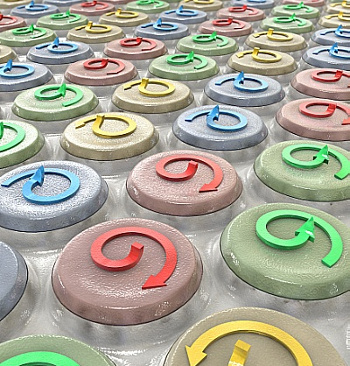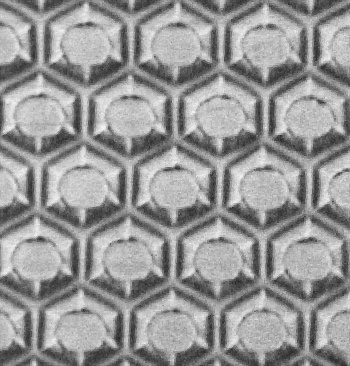Magnetic Vortex Disks
March 30, 2011
Many years ago, I was making tiny disks of the
magnetic material,
yttrium iron garnet, also called YIG, from thin films I had prepared on
non-magnetic substrates. This was essentially a follow-up study to improve on a material that had been previously patented by my employer.[1] The advantage I had in doing this research was that I had one of the few laboratories in the world that could produce such films; and I had learned a few tricks making similar films of related materials for
magnetic bubble memories. I mentioned magnetic bubbles in a
recent article (Spintronics, February 1, 2011).
The intended use for these disks was as a
resonator for
microwave applications.
Magnetostatic wave resonators made from tiny
spheres of YIG had been used for years in extremely high frequency oscillators. The frequency of such oscillators can be changed by changing the magnetic field, which is both an advantage, and a disadvantage. The disadvantage comes from the temperature dependence of
magnetic materials. Other disadvantages are that the YIG material needs to be fabricated into extremely perfect spheres; and the spheres need to be oriented and generally hand assembled into their circuitry. The disks were intended to solve some of these problems.
There was another use for such disks. This was as a
memory element in a
magneto-optical memory.[2] Such a function was possible, since these disks are magnetically stable in two states, with a magnetization vector going either into, or out of, the disk; and YIG is a
Faraday rotator material.
Researchers in
Germany have just published an article in the current issue of
Advanced Functional Materials describing how they've created a
nanoscale version of a sea of magnetic disks using a
self-assembly trick.[3-4] This material utilizes a
science-fiction sounding state called a magnetic
vortex.

Artistic representation of vortex states in nanoscale magnetic disks.
Image: Helmholtz-Zentrum Dresden-Rossendorf
As the figure above illustrates, there are two possible vortex states in such disks, as indicated by the clockwise and counter-clockwise arrows. These show the general
magnetic field alignment in the material at the edges of the disks. Because of an effect known as
shape anisotropy, the magnetic state with least
energy is the one in which the magnetic field lies in the
plane. This situation changes when the disks become very small, since at the center of the disks the short range interaction between
electrons favors a parallel alignment of their
spins. For that reason, the magnetic field
vector pops out of the plane, and its direction is called the
polarization of the vortex. You can see how the two polarizations can translate into the "1" and "0" states of a memory.
To create a sea of disks only a few hundred nanometers in diameter in a
soft magnetic thin film, the researchers first created a self-assembled array of 300-nanometer
silica spheres on the surface. These spheres act as an array for an
argon ion etch, and during the etch their diameter shrinks from 300 to 260 nm. In the end, there's a nicely-defined array of magnetic disks. As a convenient side effect, the exposure to the ion etch is longer in the region where the spheres first touched. For this reason, the edge of the disks have a slant, which promotes the stability of the magnetic vortex in the disk.
Such a material will be useful for the spintronic devices I reviewed in a
recent article (Spintronics, February 1, 2011)

Not quite nanoscale.
Truncated pyramids in a YAG film used for an optical application.
The pyramids, on 25 μm centers, were formed by etching a (111) YAG wafer to expose (211) facets.
(Author's image. [5])
![]()
References:
- Michael Nemiroff, Hong Jun Yue, William Russell Schevey, "Yttrium iron garnet disks on gadolinium gallium substrates for microwave applications," U.S. Patent No. 4,060,448, November 29, 1977.
- Christoph Schmelzer, Reimar Spohr, Jens-Peter Krumme, Klaus Witter and Heinrich Heitmann, "Magnetic memory layer," U.S. Patent No. 4,274,935, June 23, 1981.
- Roland Knauer, "Mini Disks for Data Storage - Slanted Edges Favor Tiny Magnetic Vortices," Press release, Helmholtz-Zentrum Dresden-Rossendorf, March 14, 2011.
- N. Martin, N. C. Bigall, I. Mönch, T. Gemming, A. Eychmüller, R. Mattheis, R. Schäfer, L. Schultz and J. McCord, "Circular Nanomagnets: Enhanced Nucleation of Vortices in Soft Magnetic Materials Prepared by Silica Nanosphere Lithography," Advanced Functional Materials, vol. 21, no. 5 (March 8, 2011), pp. 801-805.
- D.M. Gualtieri, H. van de Vaart, T. St. John, and R.C. Hebb, "High Luminance Monochrome Faceplates for Compact Projection Displays," Journal of the Society for Information Display, vol. 1, no. 2 (1993), pp. 123-127.
Permanent Link to this article
Linked Keywords: Magnetism; magnetic; yttrium iron garnet; gadolinium gallium garnet; non-magnetic substrate; magnetic bubble memory; resonator; microwave; magnetostatic wave; sphere; magnetic material; random-access memory; memory element; magneto-optical; Faraday rotator; Germany; Advanced Functional Materials; nanoscale; self-assembly; science-fiction; vortex; Helmholtz-Zentrum Dresden-Rossendorf; magnetic field; shape anisotropy; energy; plane; electron; electron magnetic dipole moment; electron spin; vector; polarization; soft magnetic material; silicon dioxide; silica; argon ion etch; spintronics; yttrium aluminium garnet; YAG; Miller index; (111); (211).